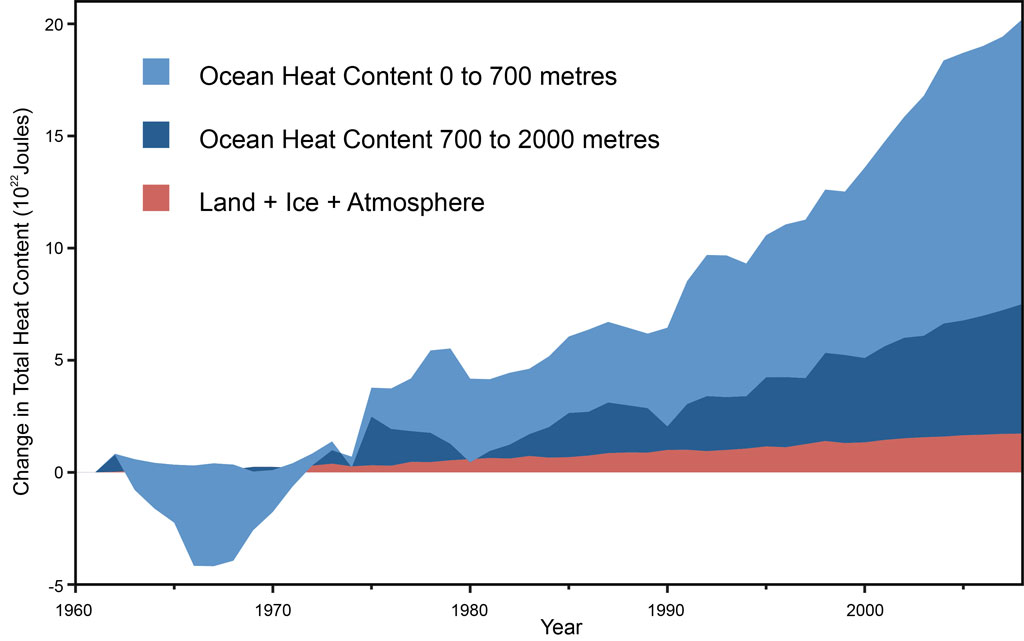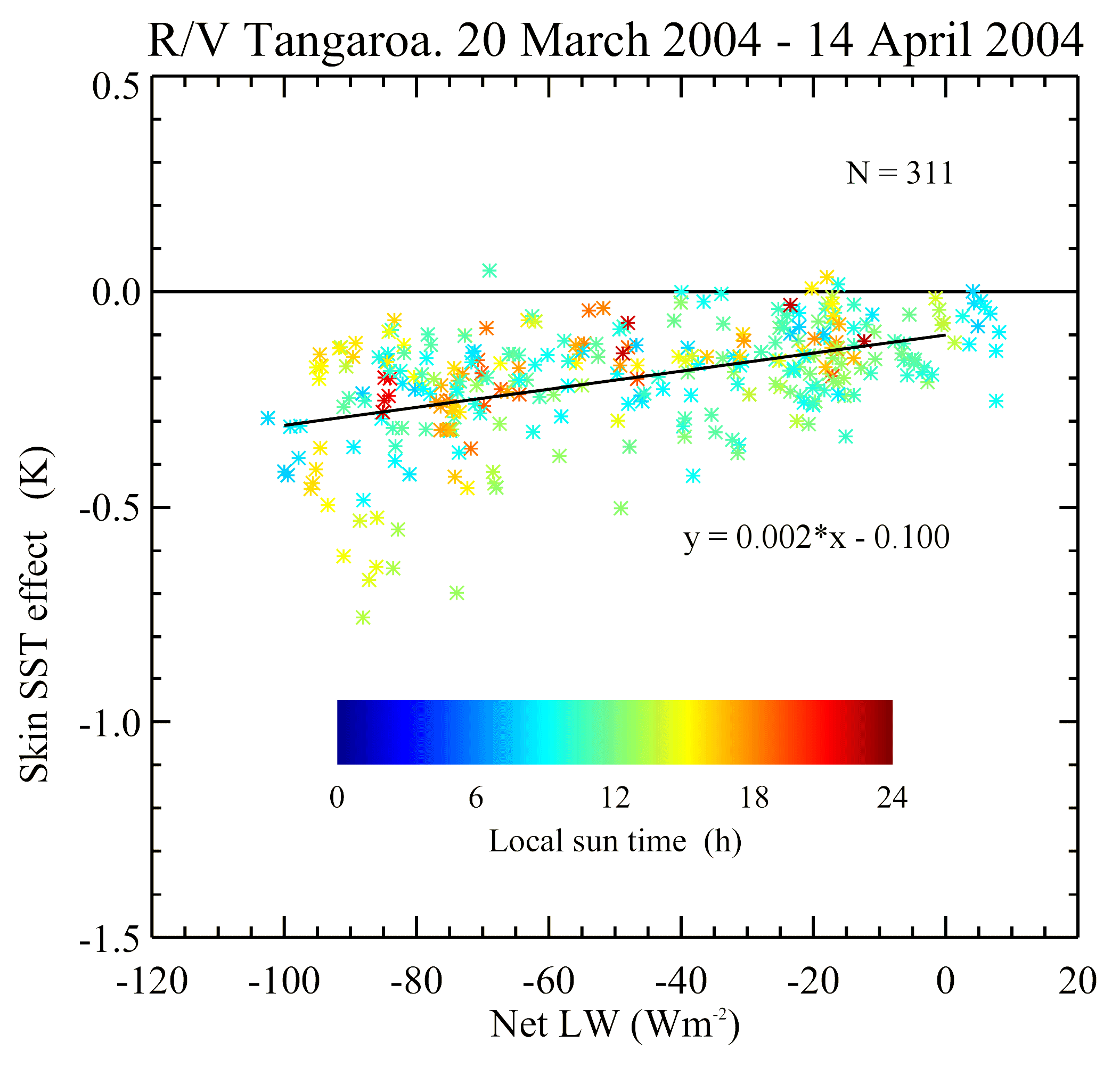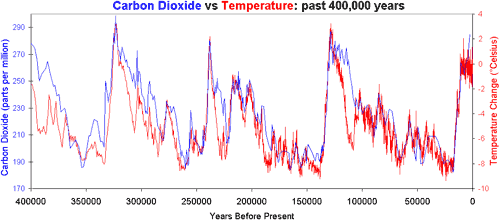
Key Points:

Figure 1 - Spin-up of the South Pacific subtropical ocean gyre centered near New Zealand between 1995-2004. As the wind-driven ocean circulation intensifies surface water is pushed toward the centre of the gyre where it piles up and raises the local sea surface height (anomalies shown are in cm). With the gyre spinning faster, and nowhere else to go, the water is pumped down into the ocean interior by a process known as Ekman pumping, and thereby warms the deep ocean. Animation created from images in Roemmich (2007).
The anomalous warming of the deep ocean over the last few decades has received a great deal of attention on climate-related blogs and in the mainstream media, but there has been little discussion of the mechanisms driving this deep ocean warming. Contrarians often seem to think that the warming of the deep ocean can only be accomplished by magic, or Star Trek-style teleportation devices, however that probably stems from basing their expectations on some gut instinct of how they feel the ocean should behave. The oceans don't behave according to gut instincts, they behave according to the laws of physics and, sadly, much of the physics is not very intuitive at all.
It is hoped that some of the fundamentals of oceanography conveyed in this series of posts will enable readers to appreciate, for instance, why the surface currents (shown in Figure 1) converge around New Zealand and are directed downwards into the ocean - taking surface heat with them. But more importantly, it is hoped that readers realize that, despite an incomplete picture of all the details, there is a great deal known about the ocean circulation, and that it plays a large role in recent global temperature trends.

Figure 2 - Land, atmosphere, and ice heating (red), 0-700 meter OHC increase (light blue), 700-2,000 meter OHC increase (dark blue). From Nuccitelli (2012).
Over the last 3 decades the sun has seen a very slight decrease in the amount of solar radiation it puts out. In spite of this, there has been a tremendous build-up of heat in the ocean (see Figure 2), especially the deep ocean (Levitus [2012], Nuccitelli [2012], Balmaseda [2013]). Given that the heating of the oceans is almost entirely due to sunlight (in the form of shortwave radiation) entering the surface layers, this raises the question of how this ocean warming is possible. Why are the oceans warming so much when the main source of heat input into the upper ocean has diminished slightly?
As discussed in this SkS post, and the Real Climate post by Professor Peter Minnett it is based upon, the oceans are warming due to an increase in the greenhouse effect. The oceans are heated from sunlight entering the surface, and because they are typically warmer than the overlying air, the net flow of heat is from the warmer surface ocean to the cooler atmosphere above. Turbulence is suppressed at the ocean-atmosphere boundary, so heat has to travel through a conductive layer within the cool-skin - the thin surface layer of ocean in contact with the atmosphere. The rate of heat flow is, therefore, determined by the thermal gradient through the cool-skin layer (Saunders [1967], Grassl [1976].
As additional greenhouse gases accumulate in the atmosphere, they trap more heat (longwave radiation) and reflect more of it back toward the ocean surface. Strong absorption of longwave radiation occurs in the cool-skin, but is compensated by the powerful emission (loss) of longwave radiation to the atmosphere at the ocean surface (e.g. Konda [2004]) This blocks heat from reaching the ocean below the cool-skin, but it does warm the upper portion of the cool-skin layer and the thermal gradient through the layer is therefore reduced. In doing so, this lowered thermal gradient slows the flow of heat out of the ocean and causes the oceans to grow ever warmer over time. So, in a similar manner to that where greenhouse gases trap heat in the atmosphere by reducing heat lost to space, they carry out a similar function in warming the surface oceans by reducing heat lost to the atmosphere.
 Figure 3 - observations carried out aboard the New Zealand research ship Tangaroa shows upper ocean warming when the cool-skin layer is warmed by stronger downward longwave radiation (heat) brought about by increased cloud cover (i.e. more heat is reflected back toward the ocean surface by clouds than comparable clear-sky conditions). The vertical axis is the temperature difference between the skin layer and the ocean bulk 5 cm's below as a function of longwave radiation (horizontal axis). Image from Real Climate.
Figure 3 - observations carried out aboard the New Zealand research ship Tangaroa shows upper ocean warming when the cool-skin layer is warmed by stronger downward longwave radiation (heat) brought about by increased cloud cover (i.e. more heat is reflected back toward the ocean surface by clouds than comparable clear-sky conditions). The vertical axis is the temperature difference between the skin layer and the ocean bulk 5 cm's below as a function of longwave radiation (horizontal axis). Image from Real Climate.
The observations depicted in Figure 3 show that as the longwave radiative forcing increases (becomes less negative - as plotted), the surface oceans become warmer. Despite this cloud-forcing effect being a great deal stronger than greenhouse gas forcing, the measurements offer up observational evidence of the tendency of the reduced thermal gradient in the cool-skin layer to warm the surface ocean.
It's now possible to understand why the ice core records over the last almost-million years show such a strong correlation between CO2 (the main greenhouse gas) and global temperature - not only do greenhouse gases trap heat in the atmosphere, they trap heat in the ocean, warming up the entire Earth system over time.

Figure 4 - the relationship between atmospheric CO2 and global temperature (and therefore ocean heat content too) over the last 400,000 years, as indicated by the Vostok ice core in Antartica.
This mechanism also helps to explain why the Earth has gradually cooled over the last 50 million years (Lear [2000], Zhang [2011], Anderson [2011]), despite the sun growing warmer over this period of time. As the atmospheric concentration of carbon dioxide has gradually declined, so too has the temperature of the atmosphere and oceans.
The beauty of the concept of the increased greenhouse effect is that it has great explanatory power and enables us to solve some pieces of the great climate puzzle. CO2 is not the only factor of course, but for many periods of the past we can see why the oceans warmed or cooled in deep time, why they warmed and cooled over the last million or so years, and why they are warming now. But it doesn't tell us everything about the changes we have observed over recent decades. That requires knowledge of the wind-driven ocean circulation, a natural phenomenon that moves back-and-forth between phases of intense or sluggish circulation over decadal timescales, and therefore alters the short-term rate of ocean heat uptake.
This natural oscillation in the global oceans is largely responsible for the recent deep ocean warming because, at times when the circulation is strong, it removes heat from the surface layers and pushes it down into the ocean interior. But before examining the wind-driven ocean circulation, it makes sense for us to first look at some of the factors which influence its general behaviour - appreciating why it works the way it does, rather than just how it works. A greatly neglected consideration in blog-related discussions is the Earth's rotation, but this is probably the largest dynamical influence over the global oceans. This will be the subject of the next installment.
Next: Deep Ocean Warming and the Coriolis Effect
Posted by Rob Painting on Monday, 28 October, 2013
 |
The Skeptical Science website by Skeptical Science is licensed under a Creative Commons Attribution 3.0 Unported License. |